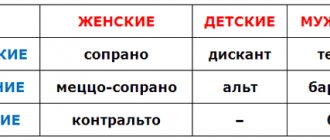As you know, the power of the voice serves as an excellent aid in the activities of professional artists who earn their living by using their voice in their work. However, strength and confidence in the voice can serve well not only people, so to speak, creative, but also completely ordinary people engaged in ordinary mundane affairs, developing their own business, advancing in their career, and simply those who are used to and love interacting with other people .
It's no secret that through proper placement of accents in the voice, setting stress and other similar manipulations, you can achieve a truly amazing effect, for example, have the necessary influence on people during negotiations, create a first-class impression of yourself, or influence any person in such a way as to so that it does what you need.
But can people with weak voices somehow influence it to become stronger? Of course they can, because there are many effective ways to do this.
Advice from singer and vocal teacher Alexey Kovalenko.
How to improve the sound of your voice? To ensure that your voice sounds loud, your vocal cords do not strain and you do not feel tired during a long performance, the lessons of vocal teacher Alexey Kovalenko will help you with this.
Singer and vocal teacher Alexey Kovalenko gives advice on how to improve the sound of your voice, develop true resonant speech and correct singing. The main thing, he believes, is that you first need to deliver a beautiful speech at resonance and then sing correctly.
What role does the voice play for an actor?
For an actor, the voice is the most important professional instrument with which expression and expressiveness are achieved. Therefore, in classes at the Benefis theater studio, a lot of attention is paid to working with the voice.
From the very first lessons you receive a series of exercises for correct sound. The teacher will evaluate your skills and capabilities, tell you what you are missing and what you need to work on. Typical problems: voice is too quiet, problems with the pronunciation of vowels, consonants, hissing sounds, resonators do not turn on very well, etc.
At each lesson at the Benefis theater studio, 15-30 minutes are devoted to speech lessons, in addition, the teacher gives homework on speech for every day. It is very important to work on your speech regularly: every day for 10-20 minutes - only in this case the result will not be long in coming.
During the first lesson, the teacher listens to each student’s speech and notes the problems that need to be worked on. If a person really tries and regularly works on his speech, then already at the tenth, final lesson, his voice begins to sound very good - and this amazing result is noticeable to everyone.
Our teachers in the classroom provide students with all the necessary tools that enable such a transformation to take place. You just need to follow the recommendations of professionals step by step, and soon you will notice that your speech has become beautiful, clear and correct.
Exercise to relax the muscles of the larynx.
I will give one of Alexey Kovalenko’s exercises for relaxing the muscles of the larynx.
A very effective exercise for relaxing the muscles of the vocal apparatus - “Correct yawn”
A person has many muscles of the vocal apparatus - about 75-85 pieces. But there are basic muscle groups that are necessary to make your voice sound beautiful, free, relaxed and pleasant.
Diagram of the structure of the throat.
The larynx is considered one of the most important organs that produces our voice; it is in the larynx that the initial sounds and tones that form the vocal cords are born. Then these sounds, being transformed, are voiced in resonators, in the upper cavities, throughout our body, in our mouth, and then come out in the form of a voice.
Therefore, if the larynx is clamped, and for most people this is exactly the case, the voice will not come out freely. The voice will be constantly compressed, ugly and there will be many problems with the voice, namely tension and the inability to speak for a long time, lack of resonance in the voice and lack of resonance in speech.
Who needs to correct their voice?
In general, the voice, like everything else, is a matter of taste. Some people like more brutal notes, others are attracted to ringing, high-pitched voices.
As a rule, those whose professional or other activities involve influencing the public have to work on their timbre: presenters, teachers, journalists, trainers, managers, businessmen.
There are also those who by nature have a timbre that, it would seem, does not quite correspond to their appearance. For example, imagine a broad-shouldered, two-meter man with a thick beard and an unnaturally thin, shrill voice. Most likely, he has heard from others more than once about this dissonance and experienced discomfort.
It is believed that a low, deep timbre gives the impression of confidence, calm, restraint, and firmness. Some scientists explain this from an evolutionary point of view: a rough voice was associated with strength and large size of its owner, and therefore aroused respect and some fear.
If you work with a microphone and you are not satisfied with your own sound, if your voice causes discomfort to others or you are unable to control it well, if you simply want to improve the functioning of the vocal apparatus, below you will find many techniques and recommendations that will help make the timbre lower and more pleasant for hearing.
Attention! If you are a teenager whose voice is currently going through a period of mutation, you need to do the exercises in a gentle manner. Don't overstrain your ligaments! Allow your body to adjust itself at a pace that is comfortable for it. Give preference to breathing exercises, work with articulation and diction.
More than 100 cool lessons, tests and exercises for brain development
Start developing
Exercises to relax the muscles of the larynx.
In this lesson, we will learn how to relax the muscles of the larynx to improve the sound of your voice.
The larynx is located right here. You can feel it calmly. That is, the place where your Adam’s apple is located, or it’s correctly called the thyroid bone. When you touch it, you feel the bone here. This is the thyroid bone. It covers and protects your vocal cords, which are located in the larynx itself. The larynx is very large.
That is, it is like a box in which the vocal cords are located. In the area of the larynx there is a huge number of muscles used in the process of sound production.
If a person has a muscle spasm in the larynx, then the person’s voice will not sound free, bright and easy.
Alexey Kovalenko looked everywhere for information on how to relax the larynx and found many different methods, but they were very ineffective because they were not natural.
He observed this exercise in animals, namely cats and dogs. This process occurs spontaneously and naturally for them. This exercise is called “Correct Yawn”.
How to make your voice stronger?
Firstly, it should be said that the method of increasing voice strength consists of three important components:
- The first and most important thing is to train the parts of the body that take part in the process of voice formation: vocal cords, muscles of the larynx, chest, etc.
- The second component can be called the work of training competent and correct pronunciation of the strongest sounds found in human speech
- And the third factor is adherence to a special diet, i.e. eating certain foods
Let's look at each of these points in more detail.
Exercise “Correct yawn” (technique):
- Open your teeth. Make your jaw just hang.
- Now imagine as if you are traveling on a train. If you have traveled on a train, you have probably noticed that when you travel long distances on a train, you feel very sleepy.
- Your teeth are loose. Your jaw hangs and you fall asleep; soon you will begin to yawn naturally. But don't make any sudden movements. That is, follow the movements of your body, the movement of your jaw.
- If you yawn very quickly, most muscles will only become overstrained. Take any animals, for example, cats and dogs - they never yawn quickly. They enjoy the process.
- So imagine that you are just riding on a train, and that your jaws are completely relaxed. You are relaxed and yawn freely. The whole body is relaxed. The main thing is that you simply follow this process. And you are not trying to interfere in this process.
- If you do this 10 or 12 times, you will already feel your voice begin to sound much brighter because you are relaxing the larynx.
In order to further enhance the effect, in order to further relax the muscles of your cheeks, all the muscles of the face, and the muscles of the neck, perform the “Full Yawn” exercises, that is, exactly as animals do.
What can you do in a week?
If you have the task of preparing a song for a holiday, then in a week you can improve the following points:
- Choose the right song. Perhaps the composition you chose is too complex or simply not suitable for you. The teacher will help you choose a piece that will show your voice to its advantage.
- Start breathing correctly. It will be difficult to achieve automaticity in a week, but you will still feel positive changes when singing.
- Work on the purity of performance by learning the melody. The teacher selects the melody of the voice on the piano - this makes it easier for people with an underdeveloped ear for music to hit the notes and learn the melody of the song more easily.
- Get rid of ear-piercing moments. For example, there may be places where you sound too nasal or start shouting, don’t have time to catch your breath, and sing with a thin, trembling sound. Emergency help from a vocal teacher will help clean up these places, and overall your performance will look better.
Full Yawn Exercises
- Now we need to add something. Also open the teeth. Close your eyes and imagine you are riding on a train and falling asleep, but you are smiling at the same time. And your smile does not disappear in the process. Just smile.
- Your teeth are loose. We imagine that you fall asleep, but with a smile, and at the same time you make a smooth, slow yawn. Don't worry about straining your jaw muscles. That's how it should be. The muscles of your larynx are also stretched.
- This is a simple exercise, but very effective. If you do it, you will get very good results in relaxing the muscles of your larynx.
Finally, I want to tell you an interesting thing. In our society, it is not natural to yawn. We constantly hold back this process, even when our body demands it. We close our mouths, or we yawn to ourselves. But in fact, this is unnatural, because your muscles require stretching and relaxation. And just a yawn is what you need - it completely stretches the muscles of the larynx, which are usually not trained.
And therefore this exercise is a workout and actually yoga for the muscles of your larynx. It helps improve the sound of your voice. It’s just that, according to Alexey, he has never seen anything more effective than this exercise.
You can go to the zoo and just watch how the animals yawn, watch how they do it and try not to rush anywhere.
Try to set aside time for studying. Set aside at least 5 or 10 minutes for this exercise so that no one disturbs you. Just enjoy this process, the process of doing the exercise. You can also turn on some nice music. Or imagine something, meditate.
I really hope that this exercise will help you relax the muscles of your larynx, and your voices will sound even better, even more beautiful.
Link to exercise, video:
Share link:
How useful is the publication?
Click on a star to rate!
Average rating 5 / 5. Number of ratings: 1
No ratings yet. Be the first to rate.
Speech apparatus muscle training
Exercises for voice development without training the speech apparatus will be incomplete. To get a beautiful sound of your speech, you need to train the muscles of the lower jaw, tongue and lips.
Exercises to strengthen the lower jaw include the following exercises:
- Open your mouth and hold your lower jaw down for 5 seconds. Then slowly close your mouth.
- We make movements with the lowered lower jaw to the right - to the left. We perform them at a slow pace.
- We bring the lowered lower jaw forward and return it to its natural position. Conducts classes at a slow pace.
Tongue muscle training is mandatory. Sedentary, underdeveloped tongue muscles cause unintelligible speech. The exercises will be as follows:
- You need to roll your tongue into a tube.
- We stick our tongue out of the mouth as far as possible. Move it up-down-right-left.
- Lick your lips, paying special attention to the corners of your mouth.
- Click your tongue actively.
Exercises must be performed at a free pace, without muscle tension.
Exercises to strengthen the facial muscles and lips include the following exercises:
- Mouth closed. Raise/lower your lips without opening your gums. The facial muscles should not tense.
- Stretch your lips in a closed smile, and then fold them into a tube.
- Massage your lips: gently knead the upper teeth with your lower teeth, and gently knead the lower with your upper teeth.
- Fold your lips into a tube and move them left and right.
The muscles of the pharynx also need training.
- You need to repeat the sounds I, U in turn. First in a whisper, then out loud. You should feel muscle tension in the throat area. A total of 15 repetitions. The exercise helps in developing the mobility of the laryngeal muscles.
- You need to suck in air through clenched teeth.
- We stretch our lips out like a duck and suck in air.
- Imitation of chewing food. First with his mouth open, then with his mouth closed. The muscles of the larynx, soft palate, tongue, lips and pharynx receive the load.
Article:
1. “Calm the doll”
Goal: development of voice power.
Description of the game: children sit on chairs in a semicircle. They have dolls in their hands. The teacher says: “The dolls are crying, we need to calm them down. Look how I put the doll to sleep (rocks the doll, quietly humming the tune of a familiar lullaby). Now you shake it.” Children take turns and then rock the dolls together, pronouncing the sound a .
2. “Blizzard”
Goal: development of voice strength and speech breathing. Activation of the lip muscles.
Equipment: story picture “Blizzard”.
Description of the game: the teacher shows a picture of a blizzard. Children sitting in a row depict a blizzard howling on a stormy evening. At the signal from the teacher, “The blizzard is beginning,” they quietly say: oooh...; at the signal “The blizzard is ending” they speak more quietly; at the signal “The blizzard is over” they fall silent. It is advisable that children change the strength of their voice at least 2-3 times in one exhalation. In this case, it is more convenient to replace the teacher’s verbal instructions with conducting: a smooth movement of the hand up - the children speak louder, a smooth movement of the hand down - the children speak more quietly.
- "Beep"
Goal: same as in the previous game.
Description of the game: children stand in a row facing the teacher and raise their arms up from the sides, touching with their palms, but do not clap. Then slowly lower it down through the sides. Simultaneously with lowering their hands, children pronounce the sound u, first loudly, and then gradually more and more quietly. They lower their hands and fall silent.
First, the teacher himself shows the actions, then calls two children who perform the actions together with him and pronounce the sound, the rest of the children only make movements with their hands. Then the whole group plays.
4. “Who wins?”
Goal: development of voice strength and speech breathing. Activation of the muscles of the lips and lower jaw.
Description of the game: the teacher calls two children and puts them facing each other. At the teacher’s signal, the children simultaneously begin to draw out, first quietly, then loudly, the vowel sounds a, o, u, i, e.
- "The wind blows"
Goal: development of voice strength and speech breathing.
Description of the game: children and teacher stand in a circle. The teacher says: “We went for a walk in the forest in the summer.” Everyone joins hands and leads a round dance, and the teacher continues: “We are walking through the field, the sun is shining, a light breeze is blowing and the grass and flowers are swaying.” The teacher and children stop. “The wind blows quietly, like this: v-v-v (pronounces the sound v quietly and for a long time). The children repeat after him. Then the movement of the round dance continues under the leisurely speech of the teacher: “We came to the forest. We picked a lot of flowers and berries. We got ready to go back. Suddenly a strong wind blew: v-v-v...” - the teacher pronounces this sound loudly and for a long time. Children stop and repeat the sound after the teacher. Methodological instruction: the teacher makes sure that the children, repeating after him, maintain the same strength of voice.
6. “Dashes”
Goal: development of voice power. Activation of the lip muscles.
Equipment: chalk, chairs.
Description: children go to their homes (outlined circles, corners of the room, chairs). At the teacher’s signal, one of the children calls another of his choice, “Ay, ay, Petya.” Petya, in turn, answers him: “Ay, ay, Vova,” and they quickly change places. Then Petya chooses another comrade and changes places with him in the same way.
- "The wolf and the seven Young goats"
Goal: development of strength, pitch and expressiveness. Improving phrasal speech.
Equipment: animal masks.
Description: children must first be familiar with the fairy tale, know the words of the goat and the wolf well, and the answers of the kids. The teacher distributes roles among the children and distributes masks. The teacher draws the children's attention to the nature of the voices. The goat and kids should speak in thin, high voices, and the wolf - first in a rough, low voice, and then in a higher voice.
Gymnastics that develops vocal power
Exercises that develop vocal strength help a person to smoothly change the dynamics of his sound.
Exercises for voice development include the following:
- You need to pronounce out loud the pairs of syllables AM-OM, UM-EM, YM-IM. In this case, the first of them should sound loud, and the second should be quieter.
- It is necessary to vocalize the syllables “AY-AY-AY”, “OH-OH-OH”, “EY-EY-EY” in the sequence loud-muffled-ringing.
- You need to imitate the growl of a dog, a steamship whistle, the buzzing of a bee, the squeak of a mosquito. The sounds are pronounced first in increasing order and then decreasing, as if an imaginary object was first approaching and then moving away.
- We sing the following syllables out loud in the form of a musical scale: MA-MO-MU-ME-WE-MI. First in order, then in the opposite direction.
Each exercise must be done 3 times. It is very important to breathe evenly.











